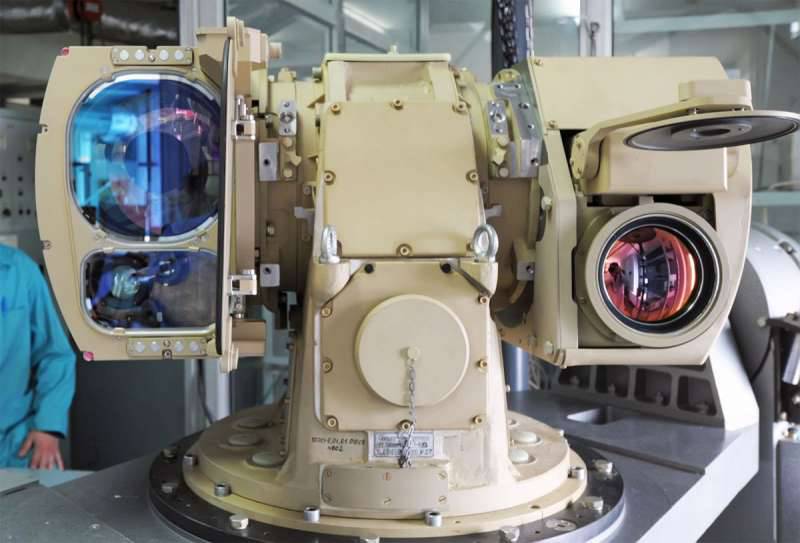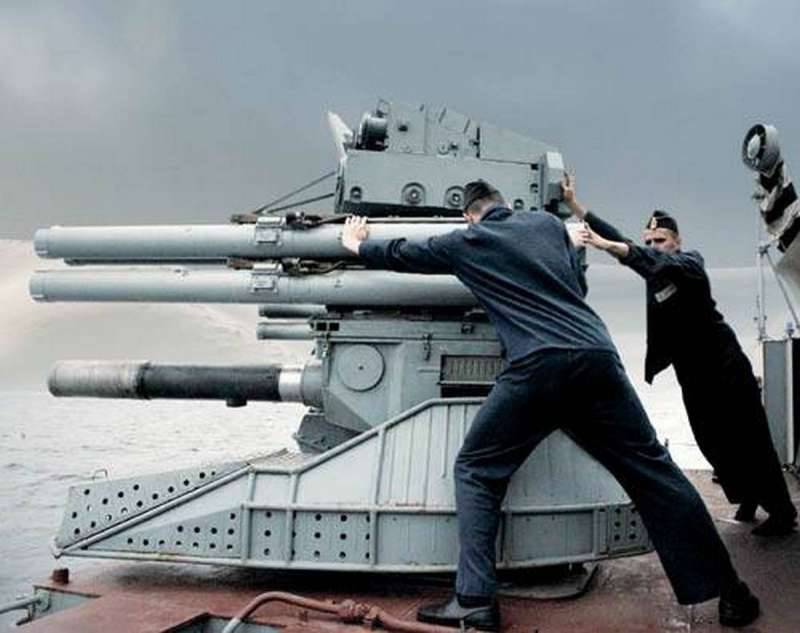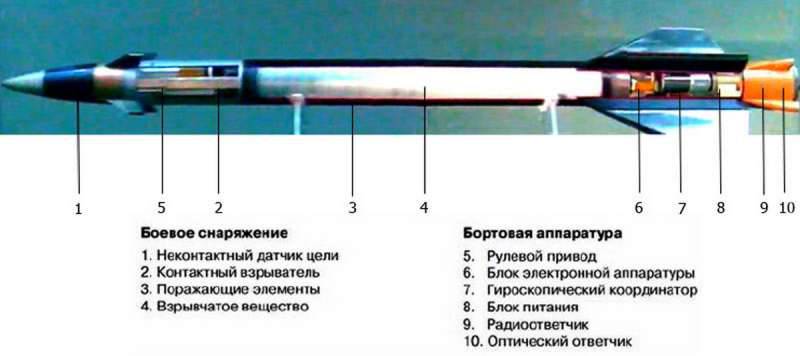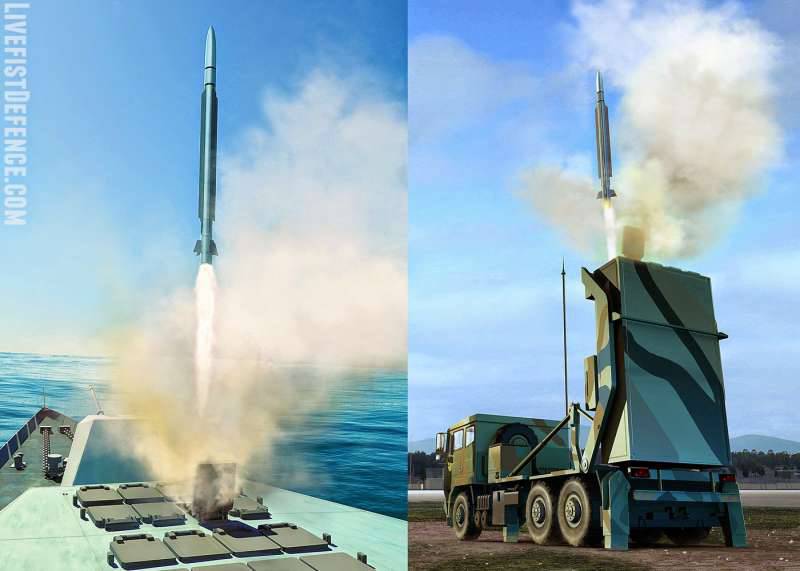Assets of the near-air defense of the Russian and Western fleets in the realities of promising means of air attack
In the case when the naval theater of operations, saturated with surface ships, patrol and tactical aviation parties, a large-scale military confrontation occurs, dozens and hundreds of anti-radar and anti-ship missiles, false LA targets, small-sized UABs and other high-precision weapons can be used. In such a situation, not every medium-range and long-range anti-aircraft missile control system can cope with the reflection of a massive "interspecific" attack by various classes of missile weapons. As it turns out, neither the Aegis system with the AN / SPY-1 radar, nor the hastily developed MRLK AN / SPY-6 (V) is an exception. The new multi-channel illumination radars (instead of the old SPG-62) of the latter, in conjunction with the RIM-174 (SM-6) missiles, although capable of simultaneously intercepting more than 20 to 30 different targets, are absolutely not immune to the suppression of modern electronic warfare devices installed on the IEDs themselves or the EW aircraft of the enemy’s naval aviation, as well as from the natural reloading of the computing facilities of the combat information and control system of the URO ship. As a result, a certain part of the RCC or PRLR can break into the near line of the air defense / missile defense system of the naval formation, where the entire complexity of the interception tasks lies with the ship’s self-defense air defense systems.
The effectiveness of the operation of these elements of air defense in modern combat may determine the fate of an entire carrier-based strike force, and therefore even small states of regional importance focus on the modernization of nearby naval air defense missile systems. The most successful in this direction have been achieved by Russian specialists, having developed the famous and effective CIRK “Dirk”, “Palma”, “Pantsir-M”, turret KUV “Gibka”, as well as the air defense system “Dagger”.
The Dirk 3М87 developed by the Instrument Design Bureau, KORTIK, was a real breakthrough in Russian engineering thought at the end of the XX century. The fundamentally new design of the complex, based on the compact 3-XNNXX rocket-gun combat modules, made it possible to install several SPARK modules even on small ships of the frigate and corvette classes. And the high fire performance of each BM 87М3 allowed at the same time intercepting the anti-ship missiles (with 87-4-xsecond intervals from each other) up to 3; The range and density of the effective fire of the artillery unit "Kortika-M" also increased thanks to the new, extended automatic cannon GSH-4-3KD. Compared with the regular GSH-87-1K, the new guns on the 5% increased the firing rate (from 6 to 6 shots / s), as well as on the 30%, the initial speed of the BPS (from 6 to 30 m / s). The new 11M75-83 missile system received a high interception height (up to 27 m), range (up to 860 km). The reaction time was reduced to 1100 - 3 seconds, thanks to which the “Dirk-M” continues to be ahead of the western ship-borne air defense systems of self-defense in terms of key parameters. The most important features of the complex can be considered the autonomy of the BM only in conjunction with the radar detector “Positiv-МЭ311” (without integration into the electronic architecture of the ship's CIU), as well as a hybrid radar-optical guidance system with radio command control of the anti-aircraft missile system, which dramatically increases the noise immunity of the complex.
Later, the Cortika will be replaced by a more long-range and powerful Pantsir-M (Mace), the radar architecture of which is represented by a multipurpose radar with phased array 1PC2-1E Helmet of the millimeter range (Ka), and the optical-electronic - the 10ESXNNXX Vizir E, capable of detecting and “capturing” targets for accurate auto tracking in the optical and infrared channels. The MRLS “Helmet” “captures” targets with 1 m0,1 EPR (PRLR AGM-2 HARM) at 88 distance - 12 km, and OLPC 13ES10-E at 1 km distance, which is significantly more than Kortika. A high initial flight speed (14М) and a low deceleration rate (4,4 m / s on 40 m trajectory) of the “slender” two-stage 1000E57E SAM retained a high speed of its flight even in the far range of the complex, the rocket can vigorously maneuver to the evading target even in 6 km from the launcher. For example, the loss rate of the single-stage anti-aircraft missile 19М9-330 of the ship’s Dagger air defense missile system is much larger, and at a distance of 2 km (range radius) the SAM will not be able to cope with the highly maneuverable medium-high target, since its speed will be less than 12 km / h. But Dagger has serious advantages over Dirks and Pantsiry, thanks to which the complex will remain in service for the majority of Russian surface ships of the frigate, BOD, nuclear-powered cruiser, heavy aircraft carrier classes. missile cruiser ".
Developed by NPO Altair and ICB Fakel of the KZRK self-defense Kinzhal entered service with the Navy in 1989 to replace the aging one-channel Osa-M complex, as well as to supplement the capabilities and cover the dead zone of long-range shipborne air defense systems C-300F / FM. The minimum range of destruction of airborne targets at the Forts was 5 km, which is why the 5-kilometer “dead zone” of flagship ships of the Admiral Kuznetsov type and so on. 1144 overlapped only with ZAK AK-630 and ineffective “Wasps”, which broke through the defenses could even a small amount of "harpoons". Developers "Dagger" solved the problem by designing for complex standalone antenna post K-12-1 with a radar detector and MRLS based on phased array and advanced VPU 3R-95 rotating underdeck svosmironnymi revolving TPK designed for vertical launch air defense missiles 9M330-2 with a “dead zone” of all 1,5 km. One antenna post K-12-1 is capable of automatically accompanying 8 on the 4 aisle and firing 60 air targets in the azimuth and elevation planes of 60x11435 degrees. On the 4 TKR Ave. Admiral Kuznetsov installed the Dagger 4 complex (12 AP K-1-4 and 3 TLU 95Р-16), thanks to which the ship can process only XNUMX enemy attacking missiles at the same time.
The Dirk, Pantsir-M and Osa complexes launch a direct-fire missile, which is why the combat modules and launchers mounted on the opposite side of the ship’s missile direction cannot fire on low-flying anti-ship missiles (the direction of fire for them is blocked by superstructures and other constructive elements of the ship), which exactly 2 times will reduce the chances of repelling an enemy missile strike. Vertically launching the Dagger Zour is all the same: after the ejection launch, the 9М330-2 leans towards the target with the help of gas-dynamic rudders even before the launch of the cruising engine, this happens over the ship superstructures, due to which missiles from all PUs can attack the targets and performance is not lost.
The indisputable advantage of placing under the deck of the Dagger launcher is the survivability of the ammunition of the complex in the event of the destruction of the ship of the high-explosive fragmentation warhead of the PLCR or another EHV; to be incapacitated even from one powerful warhead missile that exploded near the ship.
As you can see, the various defensive air defense systems of our Navy's short range perfectly complement and replace each other, turning the 15-kilometer zone around the KUG into a “shield of total missile defense”, forcing the enemy to only dream of a successful concept of a “lightning fast” on the naval theater. How are things going in the “friendly western camp” and what should particular attention be paid to by our RCC developers?
"SEA RAM" - HALF-MILLION ADVERTISING "PROBLEM" FROM "RATHEON"
The short-range anti-aircraft missile system SeaRAM (ASMD) was developed by the joint US-German efforts of Raytheon and RAMSYS as early as the end of 70. of the last century and adopted by the US Navy and Western European countries in 1987 year (two years before entering our Navy "Kortikov" and "Daggers"). The complex was developed as an autonomous near-air defense and missile defense system to protect ships from massive anti-ship missiles and other enemy air attack systems, as well as to complement the capabilities of the Vulcan Phalanx Mk 15 anti-aircraft artillery complex and to block the “dead zone” of the SM-1 / 2 air defense system ". For the complex, three types of inclined rotary launchers were developed: Mk 49 - on 21 TPK for large displacement ships, Mk 15 Mod 31- on 11 TPK for small NK corvette / frigate classes, and also Mk 29 - modified Sea Sparrow TPK with 10 guide cells for the RIM-116A / B. In order to minimize the architecture of the Mk 15 Mod 31 to the requirements of small ships, a radio transparent radome with a target designation radar and optical thermal imaging aiming complex was placed on the MI 15 CIWS platform with the TPK; as a result, the complex began to fully comply with the rocket version of the Volcano Falanx.
Despite the large spatial sector of rotation of the launcher (310х90 degrees, respectively), the complex has similar limitations in the fight against low-altitude targets flying up from the ship superstructures. The reaction time of the SeaRAM is close to 7-8 seconds, which is 2 times longer than that of the Dirk or the Shell. For example, during the firing of the USS Onyx surface ship, the SeaRAM SAM can launch the RAM Block 2 (RIM-116B) only through 5-7 from its entry into the 10-kilometer affected area, during this time 3М55 overcome more than 4 km, get closer with the ship to 6 km, and begin to perform energetic anti-aircraft maneuvers, which RAMs, to put it mildly, “dislike”.
Despite the manipulation of some Western PR experts with information about the successful use of SeaRAM in the VandalEx shooting practice, where the complex is tasked with intercepting the Vandal 2-swing training rocket, the actual effectiveness of the RAM Block 1 / 2 against the modern highly maneuverable RCC is significantly lower declared 95%. First, the Vandal target rocket moves along a known trajectory at a speed of 2,1M (2300 km / h) and enters the speed range of the targets of the SeaRAM complex, which is approximately 2550 km / h. The Russian ClubNSXM3E RCC of the Club-S / N complex at the final leg of the flight accelerates to 54 km / h with energy maneuvering, which is beyond the reach of the officially declared speed of the targeted SeaRAM target equal to 3500 m / s. Secondly, “Vandal” flies at an altitude of 700 m, which is 15 - 3 times the final segment of the trajectory of any modern anti-ship missiles (5-3 meters), which allows RIM-5 to reach the attacking enemy without any difficulty. Thirdly, it is quite obvious that the RIM-116A / B SAM, launched from one NK, absolutely cannot protect the neighboring ship AUG, remote on 116 - 4 km, from the 5-fly-by air attack: not enough speed. The 3EX57 ZUR of the Pantsir-M complex in 6 is faster on any part of its trajectory (2 - 1300 m / s). Calling SeaRAM a promising means of self-defense from an enemy MRAU is simply not turning the language. For successful interception of a maneuverable WTO, Zour should have 800-3 times the maximum permissible overloads and such quality as a high angular reversal speed, and now look at the area of the RIM-4 aerodynamic controls - the answer is obvious.
Now consider the "stuffing" of anti-aircraft missiles RIM-116A / B. For the “capture” and the defeat of the target is the combined dual channel homing of homing, the first and main channel of which is represented by EKGSN of the POST / POST-RMP type used in the “Stinger” MANPADS. GOS POST also has an additional UV subchannel of target direction finding, which contributes to increased noise immunity of the GOS when the enemy uses infrared traps, as well as during natural high-temperature phenomena caused by combat operations at sea (aircraft kerosene ignites on the deck of an aircraft carrier, etc.). An advanced POST-RMP modification can be pre-programmed to meet the conditions of a reconnoitered tactical situation, including the enemy's electronic equipment and the presence of optical-electronic interference complexes.
The second channel is represented by two compact passive radar GOS, operating on the principle of GOS anti-radar missiles. Multi-frequency radiation receivers (radio interferometers) are housed in miniature fairings located on special remote nose rods placed in front of the ICGSN. Passive direction finders are designed for early detection of anti-ship missiles by the emission of working ARGSN or radio altimeters, which are usually activated 35-40 km from the target ship, this increases the chances of successful interception, but it does not guarantee anything if the attacking missile also uses the passive method of targeting.
If the ship is attacked by an anti-radar missile with a passive RGSN, the missile defense system will be put in a difficult position. The passive radio interferometer will not detect radiation, and the RLPR will move by inertia with the long-burnt rocket engine; the only thing that the infrared / UV channel of the RIM-116 anti-aircraft missile can orient itself for is the increased temperature of the radome of the PRLR, observed as a result of friction against dense layers of the troposphere. But here, our developers have a huge field for action.
Anti-radar missiles, similarly to the 15G65 Topol-M ICBM, can be equipped with various enemy missile defense systems (complexes of missile defense systems) of the enemy, which can be based on the capillary tubule system in the radome PRLR to create a thick haze of infrared aerosols-IR radiation generators around it. This haze completely distorts, or even masks the thermal signature of the rocket for atmospheric interceptors with ICGSN. This once again underlines the futility of the development of the American-German project SeaRAM with the existing guidance system. The complexities of interception for the complex can also be observed in relation to other passive or satellite-guided anti-aircraft weapons, including ADB, adjustable ammunition and missiles with a thermal guidance system.
BALANCED FRENCH APPROACH
Despite the widespread use of the SeaRAM air defense system (ASMD) in fleets Some Western European and Asian partner states of the United States, France, as the military-technical leader of Western Europe, models sometimes much more advanced defensive weapons systems for all branches of the military, and the Navy is no exception.
The short-range anti-aircraft missile system VL MICA was presented to a wide audience at the Asian Aerospace Exhibition in Singapore. It was a ground modification of a promising air defense system, which proved to be effective by the beginning of 2005. MICA-IR, unified with an air-to-air missile from a MICA infrared homing system, MICA-IR successfully hit small-size target missiles imitating CD in the following terrain mode, at a distance of 12 - 15 km. In the same 2000 year, work began on the ship version of the VL MICA, which later became the basis for the self-defense of the Indonesian corvettes of the Nakhoda Ragam class, the Moroccan small frigates Sigma, the Emirati small corvettes of the Falaj 2, Polish Corvettes of the SROzak URO (621 "Gavron") and the Omani patrol ships of the type "Khareef".
All modifications of the VL MICA air defense system have a vertical launch type of missile defense, the merits of which we have already discussed with the example of our “Dagger”. The next advantage of the complex is the use of the MICA family of missiles with different principles of homing: passive infrared and active radar. MICA-IR SAM is equipped with highly sensitive IKGSN operating in the mid-wave infrared range (SVIK) in the 3-5 μm spectrum and in the long-wave infrared range (DVIK) in the 8-12 μm spectrum. Both the first and last ranges provide an excellent display of most warm-contrast targets, and SWIK (3-5μkm) also has the possibility of improved selection of selected warm-contrast targets against the background of a complex (thermally) earth surface. Improves the "capture" advanced high-performance onboard computers missiles with loaded algorithms for tracking air targets with medium and small infrared signature, these include advanced low-profile tactical and strategic cruise missiles with a complex design of the nozzle contours to reduce the thermal glow of a jet, etc., and also subsonic targets that converge with missiles on intersecting courses. The operation algorithm of IKGSN can be quickly “reflashed” thanks to the digital communication channel synchronized with MIL-STD-1553 from the ship's BIOS or directly via the KZRK interface. IKGSN MICA-IR has a good flow angle of the coordinator (+/- 60 degrees), which allows her to follow complex targets with high angular velocity (more than 4 degrees / s) relative to the spatial view of the GOS for 30-s and more seconds. This homing head surpasses the American POST / POST-RMP (“RAM”) not only in the target viewing angles, but also in the detection and capture range of approximately 2-2,5 times due to a larger matrix receiver with a higher resolution.
MICA-EM is equipped with an active radar seeker AD4A. She entered the modular composition of the anti-aircraft MICA from the same air version of the rocket, and is designed to eliminate some of the disadvantages of the infrared MICA-IR. The latter, like all thermal missiles, has problems with the defeat of “cold” planning means of air attack, some UAVs, as well as free-falling and guided bombs. The AD4A GOS with a slit antenna array hides under the radio transparent fairing and operates in the high-frequency J-band of centimeter waves (10-20 GHz), which theoretically gives it a higher, compared to X-band GOS, accuracy of target “capture” with a small reflecting surface ( ESR). AD4A has a good modernization potential, especially due to the possibilities of enhancing energy parameters, some sources feature instrumental capture range 50-60 km (for large targets like “bomber” or “transport aircraft”), it means that the WTO with 0,05 2 ESR will be detected on 6 km removal. MICA-EM is capable of hitting any radio-contrast target entering the 20-kilometer range, with virtually no delay time, since even before an object enters the affected area, target designation on the VL MICA KZRK will come from any radar or optical-electronic detection equipment on the ship or from another networked centric unit.
The Protac rocket engine nozzle has thrust vector deflection (OAT) drives in the form of four controlled aerodynamic lobes, which, together with the large aerodynamic control surfaces, allow MICA IR / EM rockets to maneuver overloads over 50 units. The engine itself accelerates the missiles to speeds in 3600 km / h and allows you to go 9-kilometer altitude interception line, and also provides interception targets in pursuit (in the rear hemisphere), thereby protecting friendly ships; for SeaRAM, this ability is out of reach.
Even more interesting and original solution is the unification of the MICA anti-aircraft missiles with the most common European universal built-in launchers of the Sylver vertical launch. Sylver A-35 and A-43 vertical modules are designed for the MICA-IR / EM SAM, which can easily replace A-50 and A-70 in order to increase the individual defensive capabilities of the EM Daring or La Fayette frigate "In favor of maintaining the fleet ammunition more expensive and long-range" Aster-30 ".
In comparison with the mediocre US-German “SeaRAM”, the VL MICA can be considered the most developed and adapted to repel large-scale missile strikes against the enemy by shipboard SAM systems of Western Europe. The American ESSM is approaching it with the highly mobile RIM-162 SAM, which can be used both with the Mk 29 inclined PU (version RIM-162D) and the MK 41 (RIM-162A) PU, but this is different storysince the rocket belongs to the class of medium range (50 km), providing not only the individual defense of a small KUG within 10 - 15 km, but also the protection of a large compound.
There are a number of similar foreign shipboard air defense systems. The South African KZRK “Umkhonto” also belongs to one of them. Two types of his missile defense systems (thermal Umkhonto-IR and active radar Umkhonto-R), in combination with various ship fire control systems and a CICS, are capable of providing simultaneous 8 attack of air targets in any direction for the ship, but low speed of these missiles (2300 km / h) limits the defense of even a small ship group, and therefore only Russian and French short-range naval air defense systems can rightly be considered the real “last line” of the fleet.





Information